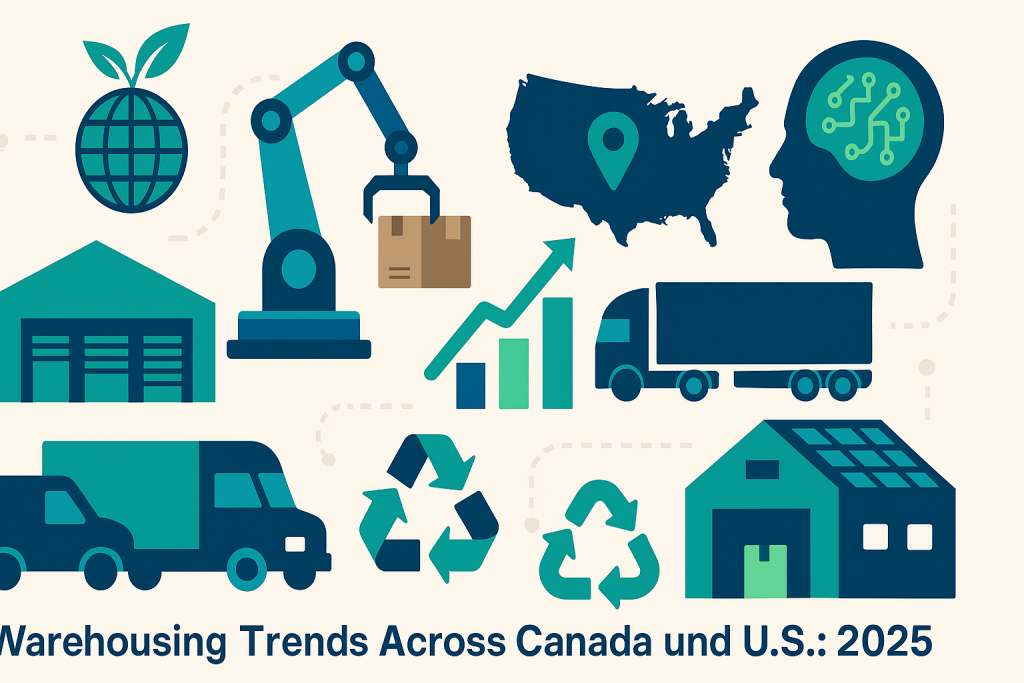By Martin Vassilev / 22 Sep, 2025
The warehousing industry is at a pivotal moment. Businesses across Canada and the U.S. are rethinking how goods are stored, processed, and delivered in response to technological innovation, global supply chain pressures, and shifting consumer expectations. The 2025 outlook signals a future where automation, sustainability, and distributed networks dominate logistics planning. Below is a comprehensive deep dive into the trends shaping the North American warehousing sector.
One of the most notable trends across Canada and the U.S. is the move toward hybrid warehousing models. Companies are no longer relying exclusively on long-term leases but are blending short-term storage solutions to meet fluctuating demand.
For example, businesses in regions like Vancouver and Los Angeles often rely on short-term storage during peak seasons to manage surges in inventory without long-term cost burdens (ByExpress insights).
On-demand warehousing is becoming a preferred solution, especially for e-commerce brands navigating seasonal changes. Platforms that allow businesses to book space as needed reduce overheads and improve supply chain agility (learn how on-demand warehousing works).
The rise of AI-powered warehouse automation has transformed productivity. From robotic picking systems to autonomous guided vehicles, warehouses are cutting labor costs while boosting accuracy. By 2026, it’s predicted that nearly 60% of warehouses across North America will integrate AI-driven robotics (ByExpress AI warehousing forecast).
AI and machine learning are not only automating workflows but also enhancing predictive inventory management. Warehouses in Toronto and New York are already deploying real-time analytics to improve order accuracy and reduce carrying costs. More insights can be found in this guide on data analytics in warehousing.
The shift toward distributed warehousing is a response to consumer demand for faster delivery. Instead of a few massive hubs, businesses are creating smaller warehouses across multiple cities. This approach reduces shipping costs and delivery times, especially critical for e-commerce giants.
In Canada, cities like Calgary and Toronto are becoming hotbeds for distributed warehousing, while in the U.S., hubs in Dallas, Atlanta, and Miami are rising. This trend supports the growth of same-day and next-day fulfillment services, as explored in fast fulfillment strategies.
As trade between Canada and the U.S. deepens, warehouses located near border cities like Windsor–Detroit and Buffalo–Toronto are expanding. Efficient cross-border storage and fulfillment allow businesses to streamline customs processes and reduce transportation delays.
Sustainability is no longer optional—it’s a market differentiator. Canadian and U.S. businesses are prioritizing green logistics by investing in energy-efficient warehouses, reducing packaging waste, and implementing eco-friendly transport options (explore green warehousing practices).
Governments in both countries are incentivizing businesses to adopt sustainable practices. For example, Canada’s Net-Zero 2050 goals and U.S. state-level climate policies are pushing warehouses to invest in solar energy, electric fleets, and smart HVAC systems. More details are available at Government of Canada climate initiatives.
Blockchain technology is improving supply chain visibility by enabling secure, real-time tracking of shipments. Warehouses in both Toronto and Chicago are piloting blockchain systems to authenticate inventory movements, ensuring higher trust across supply networks (read more on blockchain in logistics).
IoT sensors allow warehouses to monitor temperature, humidity, and inventory conditions in real time. This is particularly valuable for industries like pharmaceuticals, where compliance and safety are critical.

The rise of urban fulfillment centers—smaller warehouses located inside cities—supports last-mile delivery efficiency. Cities like New York, Toronto, and Montreal are witnessing rapid development of micro-warehouses, designed to meet the instant-delivery economy.
Retailers are turning unused storefronts into mini-warehousing hubs. This blurs the line between physical retail and e-commerce fulfillment, giving customers more pickup and delivery options.
Ottawa & Montreal: Strategic for national fulfillment and U.S. trade routes. Learn more about Ottawa warehousing solutions.
Vancouver: Gateway for Pacific trade and short-term storage demand.
Calgary: Emerging as a logistics hub with ties to energy and retail sectors.
Dallas & Atlanta: Centralized logistics powerhouses serving national networks.
Los Angeles & Miami: Key coastal cities driving international trade and e-commerce growth.
Chicago: A Midwest hub linking rail, trucking, and warehousing.
Despite automation, warehouses still require skilled technicians and logistics planners. Labor shortages in both Canada and the U.S. are pushing companies to invest in training programs and robotics integration.
Inflation, higher lease rates, and increased energy costs are squeezing warehouse margins. Businesses are countering this by optimizing warehouse space utilization (tips for maximizing efficiency).
As warehouses digitize, cyberattacks targeting inventory data and logistics platforms are becoming more frequent. Companies are investing in cyber-resilient supply chain systems.
Looking ahead, the winners in warehousing will be those who embrace technology, sustainability, and distributed networks. Businesses that strategically invest in automation, real-time analytics, and green logistics will remain competitive in both Canadian and U.S. markets. For companies evaluating their warehousing options, aligning with a trusted logistics partner is critical contact ByExpress to explore tailored solutions.

“Thanks to Byexpress all my shipping and fulfillment costs are in line now”

“All my issues were solved by Byexpress team that I had with pervious 3pl provider.”

“Thank you Byexpress team could not done it without you guys.”

“Their integration and customer service were the key for me”

“Outstanding delivery service! The package was well-packaged, and
the delivery team was professional and courteous”

“Great and knowledgeable team to work with.”

Thanks, guys, for reducing my shipping rates
Ottawa Office
2411 Holly Lane
Ottawa, ON, K1V 7P2
Toronto Office
13-280 West Beaver Creek Road Unit #136
Richmond Hill, ON, L4B 3Z1
Alexandria Office
173 Kenyon Street West
Alexandria, ON, K0C 1A0
Montreal Office
4388 Saint-Denis Street Unit #200
Montreal, QC, H2J 2L1
California Office
155 North Riverview Drive
Anaheim Hills, CA, 92808
Call Us
Toll-Free: 1-866-744-7122
Local : 613-739-3000
Email Us
Multilingual Services










